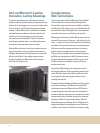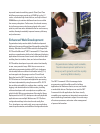
4
IIS 7.0 also provides a rich and reliable foundation for
application development. First, Windows Server 2008
contains functionality that supports running the PHP
scripting language on the operating system. Combine this
with both kernel and user caching support, and developers
have a flexible and powerful platform upon which to create
all types of compelling and dynamic content.
The productive, agile new Web platform in Windows Server
2008 is boosted by the leading performance and flexibility
of Intel Xeon processor–based servers to optimize the
hosting environment for unique business requirements.
Simply put, Windows Server 2008 runs more reliably,
securely, and quickly on Quad-Core Intel Xeon processors.
With tremendous 64-bit performance and the broadest
32-bit application support, Intel Xeon processor–based
servers offer fast Dedicated High-Speed Interconnects
(DHSI) — point-to-point intersections between each of the
four processors and the chipset. This increases throughput
to support more requests, faster page loads, and timely
application processing. For multi-threaded applications
and heavy multi-tasking scenarios, Quad-Core Intel Xeon
processors increase performance and threading headroom,
allowing a greater number of simultaneous Web workloads.
Functions are further enhanced by allowing systems to
address extended memory with more than 4 GB of both
virtual and physical memory. For greater responsiveness to
fluctuating Web workload demands, Intel Xeon processor–
based servers provide up to 12 MB shared, on-die L2 cache
with efficient L2 cache-to-processor data transfer. This
keeps more needed data closer to the cores for faster
access than off-chip memory, maximizes main memory-
to-processor bandwidth, and reduces latency.
One very noteworthy benefit is the greater scalability —
each Intel Xeon processor–based Web server readily adapts
to fluctuating site capacity as well as to variable transactional
volume. And Intel
®
I/O acceleration Technology (Intel
®
I/OAT)
further enhances this benefit. Intel I/OAT improves proces-
sor utilization and lowers latency to deliver twice the data
movement, plus more reliable I/O. Together, these features
support more requests and process network traffic faster.
Complementing these high-performance features is
energy and cost efficiency. Intel Core microarchitecture
increases responsiveness and productivity of multiple,
simultaneous workload environments, while at the same
time yielding better performance per-watt for ultra-dense
deployments. The energy efficiency gained from the Intel
Core microarchitecture helps enable highly dense 80-watt
or 50-watt processor-based rack and blade form factors.
This allows you to take back control of data center cooling,
power limitations, and space constraints caused by server
sprawl. Quad-Core Intel Xeon processor–based servers
running Windows Server 2008 reduce overall space and
electricity burdens in the data center, leading to lower
energy and footprint costs.
Intel’s rapid cadence continues with 45nm Hi-K silicon
technology. Available in Intel Xeon processor 5400
∆
series,
this next evolution in Intel Core microarchitecture includes
an extensive array of improvements, including further
energy efficiencies, increased transistor density, and
Intel I/OAT improves processor
utilization and lowers latency to
deliver twice the data movement,
plus more reliable I/O.










